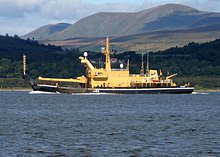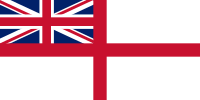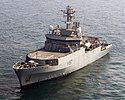Liste von Schiffen der britischen Royal Navy
| ||||||||
Die folgende Liste enthält die Schiffe der Royal Navy, Royal Fleet Auxiliary und des Royal Maritime Auxiliary Service (Stand: Oktober 2016). Ausgenommen sind kleine Landungs- und Patrouillenboote. Für ehemalige Schiffe der Royal Navy siehe Liste historischer Schiffe der Royal Navy. Die Schiffe tragen folgende Präfixe:
- HMS = His (bzw. Her) Majesty’s Ship
- RFA = Royal Fleet Auxiliary Service
- RMAS = Royal Maritime Auxiliary Service
- MV = Motor Vessel (Motorschiff)
Flugzeugträger
Queen-Elizabeth-Klasse
- Queen Elizabeth (R08)
- Prince of Wales (R09)
Docklandungsschiffe
Albion-Klasse
Atom-U-Boote
SSN Trafalgar-Klasse
- HMS Trenchant (S91)
- HMS Talent (S92)
- HMS Triumph (S93)
SSBN Vanguard-Klasse
- HMS Vanguard (S28)
- HMS Victorious (S29)
- HMS Vigilant (S30)
- HMS Vengeance (S31)
SSN Astute-Klasse
- HMS Astute (S119)
- HMS Ambush (S120)
- HMS Artful (S121)
- HMS Audacious (S122)
- HMS Anson (S123)[1]
SSBN Dreadnought
- HMS Dreadnought
Zerstörer
Type 45 Daring-Klasse
- HMS Daring (D32)
- HMS Dauntless (D33)
- HMS Diamond (D34)
- HMS Dragon (D35)
- HMS Defender (D36)
- HMS Duncan (D37)
Fregatten
Type 23 Duke-Klasse
- HMS Argyll (F231)
- HMS Lancaster (F229)
- HMS Iron Duke (F234)
- HMS Monmouth (F235)
- HMS Montrose (F236)
- HMS Westminster (F237)
- HMS Northumberland (F238)
- HMS Richmond (F239)
- HMS Somerset (F82)
- HMS Sutherland (F81)
- HMS Kent (F78)
- HMS Portland (F79)
- HMS St Albans (F83)
Hochseepatrouillenboote / Offshore Patrol Vessels (OPV's)
River
- HMS Tyne (P281)
- HMS Severn (P282)
- HMS Mersey (P283)
- HMS Clyde (P257)
- HMS Forth (P222)
- HMS Medway (P223)
- HMS Trent (P224)
- HMS Tamar (P233)
- HMS Spey (P234)

Hydrographische/ozeanographische Überwachungsschiffe
- HMS Protector (A173)
- HMS Gleaner (H86)
- HMS Scott (H131)
Echo-Klasse
- HMS Echo (H87)
- HMS Enterprise (H88)
Patrouillenboote
Archer-Klasse
- HMS Archer (P264)
- HMS Biter (P270)
- HMS Smiter (P272)
- HMS Pursuer (P273)
- HMS Blazer (P279)
- HMS Dasher (P280)
- HMS Puncher (P291)
- HMS Charger (P292)
- HMS Ranger (P293)
- HMS Trumpeter (P294)
- HMS Express (P163)
- HMS Example (P165)
- HMS Explorer (P164)
- HMS Exploit (P167)
- HMS Tracker (P274)
- HMS Raider (P275)
Scimitar-Klasse
- HMS Scimitar (P284)
- HMS Sabre (P285)
Minenabwehrschiffe

Sandown
- HMS Penzance (M106)
- HMS Bangor (M109)
Hunt-Klasse
- HMS Ledbury (M30)
- HMS Cattistock (M31)
- HMS Brocklesby (M33)
- HMS Middleton (M34)
- HMS Chiddingfold (M37)
- HMS Hurworth (M39)

Trainingsschiffe
Type 82 Bristol-Klasse
- HMS Bristol (D23)
Museumsschiffe
- HMS Unicorn
- HMS Victory
- HMS Warrior
Royal Fleet Auxiliary Service
Die Royal Fleet Auxiliary Service (RFA) ist eine weitgehend mit Zivilisten bemannte Flotte. Eigentümer ist das Ministry of Defence. Die Hauptaufgabe dieser Flotte ist die Versorgung der Kriegsschiffe der Royal Navy während des See-Einsatzes mit Treibstoff, Lebensmitteln, Kleidung und Munition, die die Kriegsschiffe benötigen, um ihre Einsätze reibungslos durchzuführen. Ferner führt sie die fliegerische Versorgung für die Royal Navy in Kombination mit amphibischer Anlandeversorgung durch. Des Weiteren ist die unterstützende Logistik in Form von sicherem Seetransport für Einheiten der British Army und deren Ausrüstungsgegenständen eine weitere Aufgabe der RFA.

Docklandungsschiffe
Bay-Klasse
- RFA Lyme Bay (L3007)
- RFA Mounts Bay (L3008)
- RFA Cardigan Bay (L3009)
Tanker
Wave-Klasse
- RFA Wave Knight (A389)
- RFA Wave Ruler (A390)
Rover-Klasse
- RFA Gold Rover (A271)
Tide-Klasse
- RFA Tidespring (A136)
- RFA Tiderace (A137)
- RFA Tidesurge (A138)
- RFA Tideforce (A139)
Flotten-Versorgungsschiffe
Fort Rosalie-Klasse
- RFA Fort Rosalie (A385)
- RFA Fort Austin (A386)
Fort Victoria-Klasse
- RFA Fort Victoria (A387)
Flugtrainings- und Verwundeten-Erstversorgungsschiff
- RFA Argus (A135)
RoRo-Transportschiffe
Point-Klasse
- Hartland Point
- Anvil Point
- Hurst Point
- Eddystone
Royal Logistic Corps
Das 17. Regiment des Royal Logistic Corps ist die maritime Komponente der British Army und stellt dieser Schiffe und Besatzungen als Ergänzung zu den Einheiten der Royal Navy bereit.
Logistische Landungsboote
- HMAV Arromanches (L105)
- HMAV Andalsnes (L107)
- HMAV Akyab (L109)
- HMAV Aachen (L110)
- HMAV Arezzo (L111)
- HMAV Audemer (L113)
Royal Maritime Auxiliary Service
Der Royal Maritime Auxiliary Service (RMAS) unterstützte wie die RFA die Royal Navy, jedoch vorwiegend innerhalb der britischen Hoheitsgewässer. Die Schiffe haben zivile Besatzungen. Der RMAS wurde offiziell am 31. März 2008 aufgelöst. Die hier aufgeführten Schiffe sind daher offiziell nicht länger Bestandteil der Marine, sondern werden von dem privaten Unternehmen Serco Marine Services im Auftrag der Royal Navy eingesetzt.


Forschungsschiffe
- RMAS Newton (A367)
- RMAS Warden (A368)
- RMAS Salmoor (A185)
- RMAS Salmaid (A187)
- MV Confidante (NP 1016)
Transportschiffe
- RMAS Oilpress (Y21)
- RMAS Colonel Templer (A229)
- RMAS Waterman (A146)
Munitionsschiffe
- RMAS Kinterbury (A378)
- RMAS Ladybird (A253)
- RMAS Tornado (A140)
- RMAS Tormentor (A142)
Personenfähren
- RMAS Bovisand (A191)
- RMAS Cawsand (A192)
- RMAS Newhaven (A280)
- RMAS Nutbourne (A281)
- RMAS Netly (A282)
- RMAS Padstow (A286)
- RMAS Oban (A283)
- RMAS Oronsay (A284)
- RMAS Omagh (A285)
- RMAS Adament (A232)
- RMAS Melton (A83)
Schlepper
- RMAS Moorhen (Y32)
- RMAS Moorfowl (Y33)
- RMAS Impulse (A344)
- RMAS Impetus (A345)
- RMAS Forceful (A221)
- RMAS Nimble (A322)
- RMAS Powerful (A323)
- RMAS Adept (A224)
- RMAS Bustler (A225)
- RMAS Capable (A226)
- RMAS Careful (A227)
- RMAS Faithful (A228)
- RMAS Dexterous (A231)
- RMAS Dalmatian (A129)
- RMAS Husky (A178)
- RMAS Saluki (A182)
- RMAS Settler (A189)
- RMAS Spaniel (A201)
- RMAS Sheepdog (A250)
- RMAS Kitty (A170)
- RMAS Lesley (A172)
- RMAS Joani (A190)
- RMAS Myrtle (A199)
- RMAS Norah (A205)
- RMAS Florence (A149)
- RMAS Frances (A147)
- RMAS Genevieve (A150)
- RMAS Helen (A198)
Zukünftige Schiffe
SSN Astute-Klasse (7 Boote, davon 5 bereits im Dienst)
- HMS Agamemnon (S124) (2022)
- HMS Ajax (S125) (2024)
SSBN Dreadnought-Klasse (4 Boote, 2 Einheiten im Bau)
- HMS Dreadnought
- HMS Valiant
- HMS Warspite
- HMS King George VI
MARS Versorgungsschiffe (3 Schiffe)
- RFA ? (202?)
Future Surface Combatant (13 Schiffe)
Fregatten
City-Klasse (Type 26) (GCS) (8 Schiffe)
- HMS Glasgow (im Bau)
- HMS Cardiff (im Bau)
- HMS Belfast (bestellt)
- HMS Birmingham (geplant)
- HMS Sheffield (geplant)
- HMS Newcastle (geplant)
- HMS Edinburgh (geplant)
- HMS London (geplant)
Inspiration-Klasse (Type 31) (GPFF) (5 Schiffe)
- HMS Venturer (im Bau)
- HMS Bulldog (bestellt)
- HMS Campbeltown (bestellt)
- HMS Formidable (bestellt)
- HMS Active (bestellt)
Siehe auch
- Ships of the Royal Navy
- Liste der Linienschiffe der Royal Navy
Einzelnachweise
- ↑ New attack submarine HMS Anson joins the Royal Navy fleet. Abgerufen am 8. November 2022 (englisch).
Auf dieser Seite verwendete Medien
(c) Photo: Andrew Linnett/MOD, OGL v1.0
Astute Class submarine Audacious under construction at Barrow in Furness shipyard in Cumbria.
Audacious is the fourth of the seven Astute Class submarines being built for the Royal Navy.
The first two boats, HMS Astute and Ambush, are currently undergoing sea trials. The third boat, Artful, is reaching the final stages of her construction at Barrow shipyard. All three are to be based at Faslane on the Clyde.
- Organization: ROYAL NAVY
- Object Name: DES-2013-087-0005
- Category: MOD
- Supplemental Categories: Equipment, Submarines, Fleet, Astute Class
- Keywords: barrow, keel laying, submarine, astute class, audacious, Royal Navy, Equipment, Nuclear, Fleet Submarines, Ship Submersible Nuclear, SSN, Construction, Building
- Country: England
(c) Albion in der Wikipedia auf Deutsch, CC BY-SA 3.0
Fregatten Type 23 HMS Westminster und HMS Iron Duke in der britischen Marinebasis de:Portsmouth. Quelle: Fotografiert von de:Benutzer:Albion am 2. August 2000.
© Crown Copyright 2012, OGL v1.0
Astute class submarine HMS Ambush is pictured during sea trials near Scotland. Ambush, second of the nuclear powered attack submarines, was named in Barrow on 16 December 2010 and launched on 5 January 2011. Having now completed her initial dive, she is in the final stages of fitting out whilst preparing for an extensive programme of sea trials. She will sail for her home port of Faslane in 2012. The seven Astute Class boats planned for introduction to the Royal Navy are the most advanced and powerful attack submarines Britain has ever sent to sea. Featuring the latest nuclear-powered technology, the vessels will never need to be refuelled and are capable of circumnavigating the world submerged, manufacturing the crew’s oxygen from seawater as she goes. The Astute Class are also quieter than any of her predecessors and have the ability to operate covertly and remain undetected, despite being fifty percent larger in size than the Royal Navy’s current Trafalgar Class submarines.
(c) Photo: CPOA(Phot) Tam McDonald/MOD, OGL v1.0
The Royal Navy P2000 Patrol Vessel HMS Dasher is pictured whilst escorting nuclear submarine HMS Vanguard to her berth at HM Naval Base Clyde, Scotland following a patrol.
- Organization: ROYAL NAVY
- Object Name: NE100530100
- Category: RNA
- Supplemental Categories: Ships
- Keywords: UK, P2000, CMU, Clyde Marine Unit, P280, Royal Navy, Equipment, Ship, Fast Training Boat, FTB, Archer Class, URNU, University, Royal, Naval, Unit
- Country: UK
(c) Photo: L(Phot) Jay Allen/MOD, OGL v1.0
River Class Patrol Vessel HMS Clyde is pictured exercising at sea.
HMS Clyde patrols the territorial seas and monitors the airspace around the Falkland Islands whilst conducting routine visits and reassurance to the many small settlements found throughout the islands.
- Organization: Royal Navy
- Object Name: MC140067017
- Category: MOD
- Supplemental Categories: Equipment, Ships, Patrol Vessels
- Keywords: Falkland Islands, Falklands, Royal Navy, Equipment, Ship, Offshore Patrol Vessel, OPV, Fishery Protection Squadron, River Class, HMS Clyde
- Country: Falkland Islands
(c) Photo: LA(Phot) Nicky Wilson/MOD, OGL v1.0
The Royal Navy's latest addition to the fleet, the Type 45 destroyer HMS Dragon is pictured exercising in the English Channel.
HMS Dragon is part of the most powerful destroyer class ever built in the UK and one of the most advanced warships in the world.
She is equipped with a state of the art air defence system which will be able to track and destroy a target the size of a cricket ball travelling three times the speed of sound. Over 150m long, Dragon will have a range of 7,000 nautical miles.
Together with her five sister ships, HMS Dragon is designed to be a flexible, multi-role vessel able to carry out a variety of tasks across the globe, from air defence to humanitarian and anti-piracy roles.
- Organization: ROYAL NAVY
- Object Name: VL110331009
- Category: MOD
- Supplemental Categories: Equipment, Ships, Destroyers, Type 45
- Keywords: Ship, Dragon, HMS, 45, Type, Destroyer, Royal Navy, Equipment, DDG, Type 45, HMS Dragon
- Country: UK
(c) Photo: Aircrew/MOD, OGL v1.0
Pictured is an aerial view of HMS Queen Elizabeth as she conducts vital system tests off the coast of Scotland.
HMS Queen Elizabeth left Rosyth, where she has been under construction since 2014, to conduct sea trials.
Type 23 frigates Sutherland and Iron Duke joined the 65,000-tonne aircraft carrier, along with Merlin Mk2 helicopters of the Fleet Air Arm, to guard the seas as the trials get under way.
The Queen Elizabeth Class Carriers are the biggest warships ever built for the Royal Navy - four acres of sovereign territory, deployable across the globe to serve the United Kingdom on operations for 50 years.
HMS Queen Elizabeth and HMS Prince of Wales will be the most advanced warships in the Royal Navy fleet.
They are the future flagships of the nation. Initially the ships will carry helicopters. The vast flight deck and hangar can accommodate any helicopter in Britain’s military inventory.
From 2020, however, our punch will be delivered by the F35 Lightning II, the world’s most advanced stealth fighter-bomber.
- Organization: Royal Navy
- Object Name: IMG_2495
- Category: MOD
- Supplemental Categories: Carriers, Ships, Equipment
- Keywords: Sailing, Action, Training, Ocean, Water, Landscape, Terrain, R08, HMS Queen Elizabeth, QE Class, Queen Elizabeth Class, CVF, Carrier, Aircraft Carrier, Ship, Royal Marines, Royal Navy, Flight Deck
- Country: At Sea
Autor/Urheber: User:Dave souza, Lizenz: CC BY-SA 2.5
RMAS Salmoor (A185) on the Firth of Clyde in Scotland, seen from Gourock.
- IMO Number: 8401999
- MMSI Number: 235003070
- Callsign: GAAK
- Length: 77 m
- Beam: 16 m
The Royal Navy mine countermeasures vessel HMS Brocklesby (M33) underway in the Arabian Gulf on 11 November 2020. Note the inofficial "Persian Gulf Yacht Club" insignia on the stack.
Autor/Urheber: User:Dave souza, Lizenz: CC BY-SA 2.5
RMAS Colonel Templer (A229) on the Firth of Clyde in Scotland, seen from Greenock Esplanade.
- IMO Number: 6619944
- MMSI Number: 233129000
- Callsign: GTTA
- Length: 56.55 m
- Beam: 10.97 m
RFA Lyme Bay berthed at Portland Port in August 2007
Autor/Urheber: UK Ministry of Defence from London, United Kingdom, Lizenz: CC BY-SA 2.0
Royal Navy survey vessel HMS Echo.
Echo was launched at Appledore in Devon in 2002, and was designed to carry out a wide range of survey work, including support to submarine and amphibious operations, through the collection of oceanographic and bathymetric (analysis of the ocean, its salinity and sound profile) data.
Her survey motor boat, Pathfinder, is capable of operating independently, supporting a small group of surveyors who can live and work ashore to carry out surveys.
Echo, which is based in Devonport, was the first Royal Navy ship to use azimuth thrusters, where the propellers are part of a swivelling pod, allowing for precise manouevring.
Capable of collecting an array of military hydrographic and oceanographic data, due to her multi-role capability Echo is also equipped to support mine warfare and amphibious operations.
To ensure she can operate in any environment she possesses a impressive array of weapons for force protection. Echo also carries a small detachment of Royal Marines.
Echo left Devonport in the first week of 2011 on a two-year deployment to the Red Sea, the Gulf, the Indian Ocean, the Middle and Far East and returned to home waters at Devonport in August 2012. After spending two months in Falmouth for a revamp, the specialist survey ship spent the final weeks of last year putting would-be navigators through their paces in the waters off the south-west of England.
© Crown Copyright 2013 Photographer: LA(Phot) Chris Wenham Image 45155676.jpg from www.defenceimages.mod.uk
This image is available for high resolution download at www.defenceimagery.mod.uk subject to the terms and conditions of the Open Government License at www.nationalarchives.gov.uk/doc/open-government-licence/. Search for image number 45155676.jpg
For latest news visit www.gov.uk/government/organisations/ministry-of-defence Follow us: www.facebook.com/defenceimages
www.twitter.com/defenceimagesDie Victory, Nelsons Flaggschiff in Portsmouth um 1900
(c) Photo: LA(Phot) JJ Massey/MOD, OGL v1.0
HMS Raider is a P2000 class Patrol Vessel linked to the University Royal Naval Unit (URNU) Cambridge.
- Organization: Royal Navy
- Object Name: 04137049
- Category: RNA
- Supplemental Categories: Ships
- Keywords: Royal Navy, Equipment, Ship, P2000, URNU, Cambridge, HMS Raider, University
- Country: UK























